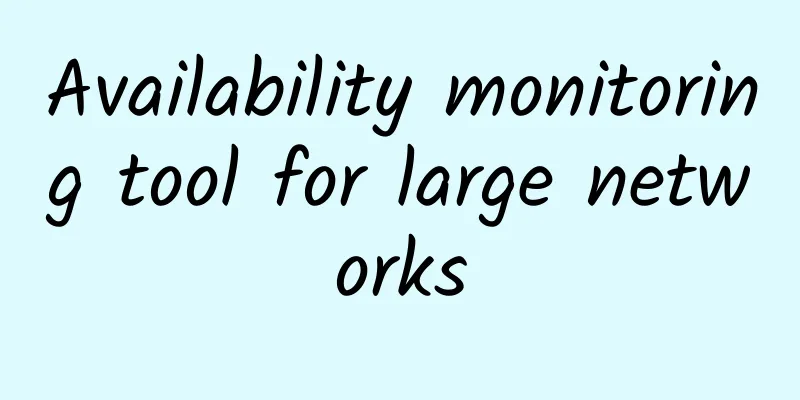Availability monitoring tool for large networks

|
No enterprise can live without network availability monitoring tools. Assessing and repairing network device failures and ensuring their availability is a basic requirement for modern data centers - especially for those enterprises that require continuous access to applications and services. While no single tool will meet the requirements of all networks, understanding the needs of your organization and the complexity of your network can help determine which availability monitoring tools will yield the most benefit. Fortunately, there are a variety of tools to meet the needs of networks of different sizes—including the smallest enterprises to the largest enterprises and service providers. To help readers learn more about network availability monitoring tools, we've analyzed some of the popular vendors' offerings. In this article, we will analyze some tools that are suitable for medium to large enterprises. CA Spectrum CA Spectrum is a product designed specifically to manage large enterprise infrastructures. It can monitor networks with more than 10,000 devices. The Spectrum network monitoring tool can discover various network devices and non-network devices and organize them into layer 2 and layer 3 network topology maps, which are then updated regularly and automatically. Its service-aware management capabilities can discover, model, monitor and manage the infrastructure that supports business services running over the network. Spectrum uses the Simple Network Management Protocol (SNMP) to detect network devices and collect event information in turn. In addition, it can collect logs and data from other network management tools and then integrate them into its own analysis tools. Management (formerly Nimsoft) to support server monitoring. Spectrum can also integrate with many other CA products, including its application performance management system and service help desk products, and it also supports integration with some third-party management systems. The Spectrum mobile app allows administrators to view up to 100 alerts on their mobile devices. CA Spectrum’s intelligent error detection capabilities enable automated root cause analysis of network problems and can correlate events to suppressed alarms that are often symptoms of the core problem. The system includes a change management feature that tracks and controls configuration changes to the network. It can associate network problems with configuration changes, helping administrators diagnose problems caused by changes and quickly fix problems on the same interfaces that have been modified. In addition, it supports a customizable role-based interface that includes reporting, alerts, and dashboards, so users can customize these tools based on their knowledge and capabilities. Spectrum 10.2 is deployed on a server as a software image that embeds its own database and analytics engine. This approach simplifies deployment and management, but limits the customizability of the platform—for example, customers cannot use third-party databases. However, the CA features and functions running on the platform are still highly customizable. Spectrum can run on Windows Server 2008 SP2 or the latest versions of Linux or Solaris servers. CA offers a tiered, appliance-based licensing model for Spectrum. It is available in both perpetual and subscription licensing models. The company provides local on-site customer support and offshore off-hours support. In addition, it maintains a customer portal that supports community discussions between individual users and a knowledge sharing center. CA also offers optional professional services for implementing Spectrum, as well as product training services. Entuity Network Management Entuity Network Management is a unified availability monitoring system designed for midsize and large enterprises. BMC Software distributes the product as a network monitoring component of its Business Service Management suite. Entuity can automatically discover and collect a variety of different information from network devices, including SNMP, system logs, link layer discovery protocol, flow and quality of service. It can automatically perform scan operations to discover all new devices added to the network. In addition, it can discover some non-network devices, but its main selling point is the network monitoring system. It can also discover and monitor virtual infrastructure, including VMware, Oracle and Microsoft hypervisors and underlying virtual switches, as well as Cisco's Nexus physical and virtual switch products. Entuity automatically builds a topology map based on the devices it discovers, monitors network errors and performance status, and finally generates reports based on the collected and monitored data. It also has built-in inventory and asset management features, and can monitor configuration changes, thereby issuing alerts when changes that violate policies are found. The product also provides an embedded and customizable event management system that can perform root cause analysis to organize alerts into incident summaries. Unhandled incidents can automatically trigger alerts to be automatically upgraded to ensure that no alerts are missed. Entuity's web-based management console enables non-IT users to create web portals in the system. These web pages are very useful for coordination between IT and business personnel, and are also very suitable for hosting service providers, who can use it to showcase their services to customers. Entuity's reporting capabilities also support customization through wizards, templates and scripts. The product's Integrated Flow Analyzer collects and analyzes network flow records, including NetFlow and IPFIX for monitoring network traffic flows. The free version of these features supports the collection and analysis of up to 2 hours of traffic summarized at 5-minute intervals, and up to 35 days of traffic summarized at daily intervals. The paid version supports flow monitoring at 1-minute intervals and some other advanced features. In version 16.5, released in the fall of 2016, Entuity introduced the SurePath network path analysis tool, which can automatically discover the network path between any two devices and then display the topology diagram between hops on the path. SurePath is integrated with Entuity Network Management, which provides customers with a visualization tool that uses the company's network availability monitoring product to help customers optimize and repair failures in monitored devices. Entuity's software supports a 30-day free trial of full functionality. The company also offers both device-based and object-based licensing. It also sells a perpetual license with maintenance services and a subscription-based license. The product is installed on a server, where its own database and analytics engine are embedded. In addition, it can be installed as a virtual machine running in a virtual machine management platform. Entuity Network Management is designed to scale to very large networks, and customers can expand their deployments by adding servers at no additional cost. The product also integrates with several third-party event management products and IT infrastructure management software, such as BMC, Oracle, IBM and HP. Entuity products can also be purchased from registered retailers. Entuity offers optional professional services, as well as onsite and online training and certification on its products. Hewlett Packard Enterprise Network Node Manager i Network Node Manager i (NNMi) is a tool designed specifically for managing large enterprise networks, and can also support networks of service providers and mobile network operators. In addition to basic functions such as availability monitoring, it can also serve as a performance management system. The product's advanced auto-discovery feature can obtain a variety of different data from discovered devices, including configuration information, virtual LANs, and physical connections between devices. NNMi will automatically generate Layer 2 and Layer 3 topology maps using the discovered data, and users can then monitor their networks based on the topology maps. In addition, NNMi can also discover and monitor large-scale non-network devices. NNMi's alarm management capabilities include event correlation and alarm escalation features, which prevent users from being overwhelmed by event alerts. It also has a plug-in catalog and asset management modules. NNMi's customizable Web-based console allows users to customize a variety of data views and dashboards to suit their needs. In addition, the tool includes some role-based and device grouping features that support segmenting large network teams into multiple domains with different monitoring responsibilities. The product's incident lifecycle management feature enables users to focus only on incidents specifically assigned to them. Advanced features of the product also include a global network management architecture that supports multiple regions, and expanded path visualization and discovery and monitoring of VMware virtual machines and underlying physical network connections. HPE has 2 versions of NNMi: NNMi Premium and NNMi Ultimate. The Premium version includes 2 optional smart plug-ins that extend NNMi from a fault and availability monitoring tool to a network performance and service assurance tool. The Ultimate Edition comes with several other optional installable smart plug-ins that support traffic monitoring, IP telephony, IP multicast, MPLS, and monitoring features. In addition, the Ultimate Edition comes with a network engineering plug-in that supports workflow automation of some engineering tasks. NNMi can be installed on a variety of operating systems, including Windows Server, HP-UX, and Linux. HPE provides connectors that support several of its products and NNMi, including HPE Operations Manager i, HPE Intelligent Management Center, and UCMDB, also HP's configuration management database product. HPE sells licenses based on the number of devices NNMi monitors, but those licenses can also be sold in tiers based on the number of features on the devices monitored. NNMi comes with an embedded database, but if an enterprise needs a customized system, they can choose to use their own database technology. HPE also offers an optional professional service that includes NNMi installation and its training courses. The product also comes with global support services that cover all aspects of the software and other HPE products that users integrate into it. In addition, HPE also provides an online portal where users can access resources such as learning, consulting and technical support. IBM Tivoli Network Manager The IBM Tivoli Network Manager platform includes a core network availability monitoring component. In addition, it is also marketed as Netcool Network Management, which is targeted at medium and large-scale enterprises and service providers. Its core features include network discovery, monitoring, event management and configuration. Although Tivoli Network Manager does not have inventory and asset management features, it can integrate with a separate IBM tool to support this function. IBM often packages Tivoli Network Manager with another network change and configuration management system, Tivoli Netcool Configuration Manager, and IBM has also introduced an advanced event management and operations analysis platform, Netcool Operations Insight, which supports alert aggregation, event analysis and event automation for multiple IBM management systems, including Tivoli Network Manager. Tivoli Network Manager can monitor tens of thousands of devices. Its centralized console specifically supports visibility and reporting, allowing users to manage large and complex environments. Users can choose different ways to view the network, including by virtual LAN, subnet, virtual private network, etc., and there is also a Network Hop View that can display all devices connected to a specified device. This platform uses multiple simultaneous and batch collection methods to discover physical and virtual network devices, including SNMP and Internet Control Message Protocol. Tivoli Network Manager can then automatically organize these discovered devices into a topology map. On Tivoli's topology map and event reports, users can right-click an object to view a series of troubleshooting instructions and device information. The product's event management capabilities use root cause analysis techniques to filter redundant alarms and isolate critical alarms. Tivoli Network Manager's advanced analytical capabilities can notify network administrators before problems occur, such as predictive alarms and trending capabilities. Tivoli Network Manager also has a portal designed specifically for non-IT users, who can create their own business-related dashboards to help them understand the status of the networks they use. IBM has introduced a perpetual Tivoli Network Manager license that is tiered per managed device, with each tier corresponding to device type, size and complexity - for example, the more complex a network device is, the more complex the monitoring data it generates, and the higher the monitoring fee. The license also includes one year of software maintenance service, which needs to be renewed annually. IBM also offers an optional Tivoli Network Manager professional installation service. This product is sold directly by IBM and its channel partners. Tivoli Network Manager comes with an embedded database and analytics engine, but customers can also use their preferred database. IBM has developed an advanced high-availability architecture for this product, which allows users to deploy multiple instances of the product in active-active or active-active plus backup mode to ensure that the tool is always online and working properly. This feature is critical for IBM's service provider customers because they must rely on Tivoli Network Manager to monitor service level agreements. SolarWinds Network Performance Monitor SolarWinds Network Performance Monitor (NPM) performance monitoring system can monitor the network as well as servers, storage, and virtualization software. NPM can automatically discover all devices in the network that have SNMP or Windows Management Instrumentation protocols enabled. Users can set the product's rediscovery feature frequency, which supports scanning and discovering new devices every hour, day, week, or month. NPM can discover Layer 2 and Layer 3 links between devices, which simplifies the process of creating network topology maps, which facilitates visual tracking of performance and availability data. Users can select discovered devices and drag and drop them into the topology creation environment. The topology creation feature automatically creates a topology map for the selected devices. Users can monitor the status and availability of network devices through topology maps, dashboards, and reports. By pulling down and selecting these views, you can view more detailed information about the device to perform subsequent fault repair, performance management, and capacity planning tasks. The product's event management system allows users to set threshold alerts, create custom alerts that correlate events to multiple devices, and customize alerts based on persistent conditions and multiple device status combinations. In addition, the event management system can filter alerts based on topology and dependency conditions to avoid redundant alerts. The product's Web console also supports drag-and-drop customization. It comes with several standard report templates, but users can also create and distribute their own reports. SolarWinds offers several NPM plug-in modules to expand its comprehensive network management, including packet-based performance monitoring. NPM integrates with several other SolarWinds products, including a NetFlow monitoring tool, an IP voice monitoring system, a server and application manager, and a network configuration management system. SolarWinds' NPM licensing is based on the number of devices and interfaces monitored. In addition, the company offers a 30-day free trial of the fully functional NPM. NPM is delivered to users as a single package. It comes with an embedded SQL database, but users can choose to use their own SQL database installed on a separate server. The software can be installed on Windows Server 2008 or 2012 operating systems. These servers can be installed on physical or virtual machines. For larger deployment environments, they may also need to add some analysis engine servers. NPM includes a one-year renewable technical support service. SolarWinds also provides 24/7 global technical support performed by internal personnel and maintains a Thwack user community and knowledge base. |
<<: It’s time to consider leaf-spine network architecture
>>: Riverbed Releases SteelFusion 5.0, Adds Support for NAS Storage
Recommend
Standard Interconnection Lightweight Cloud Promotion, Hong Kong CN2 Yearly Payment Starting from 268 Yuan
Pesyun (Standard Interconnect) has released the l...
What Software-Defined LAN Means for Campus Virtualization
Software-defined LAN, or SD-LAN, is the applicati...
Advantages of 5G technology in future US military networks
The article shows that the United States is incre...
Ruijie Wireless AP: Helping Fresh Fruits in Baiguoyuan to Extend Their Expiration Date
The story of "A horse gallops across the sky...
Smart Encyclopedia | What is a 400G optical module?
As more and more people use the internet, the amo...
Building a digital foundation: a vast expedition to reshape future education
In the past two years, with the rise of big model...
The rise of cybercrime today: how to deal with cybersecurity threats
Cybersecurity professionals are constantly protec...
Friendhosting's new Romania VPS starts from 2.99 euros per month, 25% off down payment
Friendhosting has sent out an email about a new n...
Analyzing the technology behind short videos and reopening the battle against CDN
If the live streaming industry was booming in 201...
The three major operators work together to accelerate the integrated development of "5G + Industrial Internet"
In recent years, the industrial Internet has grow...
6 IT roles that need retraining
Given the rapid pace of change in the technology ...
Huawei aims to be a smart city incubator providing basic energy
During the just concluded National People's C...
What does a Web Application Firewall do? How is it different from traditional network devices?
What is a WAF? The full name of WAF is (Web Appli...
Leading products and fast delivery: H3C helps Jomtel Mexico cope with digital challenges
Currently, in the digital trend sweeping the worl...
How can telecom operators build a new generation of network and information security system?
[[177570]] The rapid development of mobile Intern...









